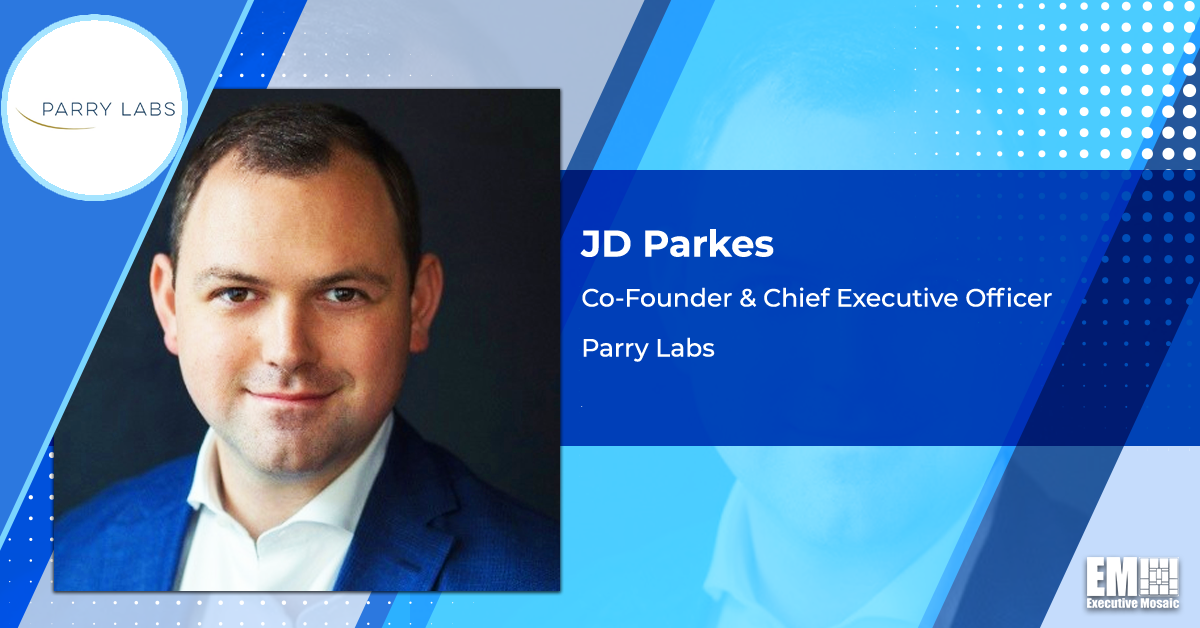John “JD” Parkes grew up attending defense trade shows with his father, who was a legacy Kodak commercial and government systems executive, so he’s always had an inherent understanding of the government contracting landscape. After Parkes earned an image science degree at the Rochester Institute of Technology, he immediately began a career serving the needs of the U.S. military.
Parkes spent time at Goodrich ISR Systems, an aerospace, defense, information and services organization which is today a part of Collins. He additionally supported the Office of the Undersecretary of Defense for Research and Engineering, advising their advanced airborne intelligence, surveillance and reconnaissance programs.
In early 2016, Parkes co-founded Parry Labs out of a desire to modernize platforms and accelerate new programs to help the warfighter maintain an advantage. The Parry Labs CEO recently sat down with ExecutiveBiz to explore the lengths his company is going to aid in the expedition of the kill chain, the trends he’s seeing in global defense and more.
Where are you seeing the most exciting opportunities to deliver better capabilities to our warfighters today, and how are you harnessing these opportunities?
There’s a lot of desire for new capabilities across the Department of Defense and the intelligence community and the technology exists in some areas but the challenge is in delivering the capabilities into programs of record. The opportunity lies in speed and scale, not the technology itself. There’s a broad desire, demand and a voice for change from the men and women in uniform and how they get capabilities sooner. Largely speaking, the opportunity is really in delivery through this shift to a digital-first acquisition strategy that’s built on edge computing, AI, autonomy and digital engineering and all these buzzwords that you hear.
Making the DOD platforms universally digital, bringing them into a place where they can be rapidly integrated and that new software can come into them, where they can all tie together and talk to each other has to be foundational whether the capability is multi-domain operations, network kill chains, combat effects or something else.
To get to where we want to go bringing all the other technologies that the DoD wants to bear, they need to build that framework of digital engineering and digital infrastructure across programs. Parry Labs is looking to solve that problem and help accelerate new software delivery to a lot of these platforms. Ultimately it reduces the cost of these programs to modify or add new tactics, techniques and procedures, capabilities, AI/ML algorithms — you name it — as they come out. It could be on a weekly or monthly basis as opposed to every six to 12 months. The reality is, a lot of these major programs are just so limited by the ability to deliver new software. It drives up the cost of the whole system and they’re less effective.
Parry’s solution is really focused on starting with the building blocks of modernizing legacy platforms and accelerating new platforms by laying down a digital foundation. Essentially, allowing all of the data, all of the systems or subsystems on a platform to be in a digital format that’s open architecture makes it addressable and accessible across networks and easily understood and easily modifiable.
What are your thoughts on how we can improve cross domain weapon systems or accelerate the kill chain and its integrated lethality?
To accelerate the kill chain, you have to start with a digital-to-digital or machine-to-machine interface. Today, if you want to talk to the cockpit of a C-130 or other platforms, sometimes it’s not a digital interface that you’re interfacing with. It’s RF or it’s a voice that you’re physically talking to exercise a command or routing it through a joint terminal attack controller.
Every platform, every system has to be in these end-to-end digital environments and they have to be modern, addressable and open to be able to communicate across domains to increase lethality. I think there are microcosms of kill chains that you can accelerate even faster than the broad, holistic DOD weapon systems by at the very least identifying what platforms can already talk to each other.
Another aspect of this that I think is really important and that Parry is focused on is what we call heterogeneous programs, like Project Overmatch or the Advanced Battle Management System. There are crosscutting programs that say, ‘I’ve got a CCA and I’ve got this other aircraft and I’ve got a ship down here. How do I now make them all work in unison?’ Whether it’s through autonomy software, whether it’s through targeting software with AI/ML, whether it’s through networking software, there are all of these next layer functions that have to occur and they have to work in tandem with legacy platforms.
When you look at how you improve these cross-domain weapons systems and kill chains, you have to both modernize the legacy platforms as well as invest in these heterogeneous effects or capabilities, which starts with updating acquisition strategies, and taking the investment to the next level, which is identifying how to make all these different systems start to work together.
What’s your outlook on the global defense landscape? What significant changes or trends are you seeing, and how are those factors moving the GovCon industry market?
At a really broad, macro level, our company and the rest of the defense community have been watching our adversaries and these gray zone conflicts that have been occurring and leveraging commercial technologies to exploit and advance in certain scenarios. I think you’re ultimately seeing a greater bifurcation in defense acquisition strategies. You’re either seeing these really exquisite, expensive technologies that prevent the war from starting because it’s such a great capability, or you’re seeing these really, really low-cost, en masse platforms enabled with rapid change.
We’re also seeing, frankly, the speed of raw warfare in Ukraine and other places. When you look at Ukraine and what they’ve been able to do, particularly with unmanned systems in the speed at which software is delivered into these unmanned systems, we can’t do that today in the U.S. Not because we can’t achieve it through existing science and physics based technology, or don’t want to, but because of our lack of acquisition strategy for digital delivery to continue to enhance those capabilities and keep them up-to-date. It comes down to how often the government buys technology. They currently acquire systems in a waterfall-based approach, focused on safety and security. It’s not, ‘how best to breed ways of delivering software.’
More and more of our nation’s critical systems and capabilities are reliant on advanced software. Can you tell us your vision of the role software will play in the future of the U.S. government?
The reality is, the U.S. defense acquisition community has yet to perfect its process and we in the defense industrial base have yet to give them a great solution. This is what Parry is really trying to solve—how can we offer someone who really knows systems and understands how an unmanned aerial vehicle flies, if it’s safe to fly, how is it airworthy? You don’t want planes to fall out of the sky. You want to shoot weapons and know that they’re going to hit the target. You want to know that a ship is seaworthy.
Regulatory concerns are extremely valid, real and important, but then you also have the speed of software delivery and how you marry those up. And today, you still have a lot of people who build aircraft, ships and tanks trying to deliver software because they’re the gating function of all these milestones. The reality is, if you build tanks, if you build planes, you have a different cost model for the government and you have a different core expertise than a software company, which really understands how to digitize and make the value of software into something.
We see the value at Parry Labs—and our collaborative objective with our customers—is to help find that optimization between the two. How can I fully be compliant with all these really important safety measures and very intricate legal requirements that we have to do as JCIDs, ACAT-1, 2 programs. And how do we bring the software and the best software possible as quickly as we can into these programs? That’s really what we’re trying to solve and help our customers work through.




